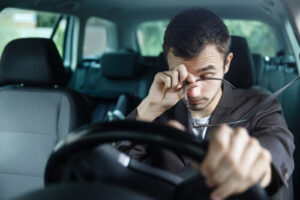How Can You Avoid Highway Hypnosis? Tips for Safer Long-Distance Driving

We’ve all been there: cruising down the highway, mile after mile, when suddenly you realize you can’t quite recall the last few exits you’ve passed. This phenomenon, commonly referred to as “highway hypnosis,” is a state of mental autopilot where a driver travels great distances without conscious recollection of the journey. It’s not just an eerie feeling; it’s a genuine concern for road safety. According to the National Highway Traffic Safety Administration, highway hypnosis contributes to over 100,000 crashes and 6,500 deaths yearly in the U.S. alone. Extended and repetitive drives can diminish alertness and decelerate response times, making it essential to avoid this trance-induced condition. So, how can you avoid highway hypnosis? This guide will delve into actionable tips and strategies to help drivers remain alert and attentive, ensuring they reach their destination safely.
Understanding the Causes of Highway Hypnosis
Why does highway hypnosis happen? Often referred to as “white line fever”, this is a state where drivers operate a vehicle in a trance-like condition, with reduced awareness of their surroundings. The phenomenon can be both intriguing and concerning, especially considering its implications for road safety. Let’s delve deeper into what leads to this trance-like state while driving:
- Monotonous Environment: Long, straight roads with repetitive scenery can lead to a lack of stimulation for the driver. Without dynamic changes in the environment to engage the brain, it’s easy for the mind to drift.
- Extended Periods of Driving: The longer someone drives without taking breaks, the more tired the brain becomes. Continuous exposure to the same activity can cause the brain to enter autopilot mode, like zoning out while reading a book or watching a movie. Therefore, you are in a state of sleep even if you do not fall asleep.
- Physical Fatigue: Highway hypnosis occurs when individuals zone out while driving a vehicle, often travelling a significant distance without recollecting it. Lack of sleep or physical exhaustion can make drivers more susceptible to highway hypnosis. When tired, the body seeks ways to rest, even if it’s not the most opportune time.
- Mental Distractions: Thinking about personal issues, daydreaming, or getting lost in one’s thoughts can take a driver’s focus off the road and cause them to forget they are behind the wheel, making them more prone to this phenomenon.
- Low Light Conditions: Driving during dawn, dusk, or nighttime can induce a hypnotic effect, especially when the only visible stimulus is the rhythmic passing of road markers or the vehicle’s headlights reflecting off the road.
Physical and Mental Symptoms to Recognize
 Identifying the onset of highway hypnosis is crucial to ensure a driver’s safety and the safety of others on the road. While highway hypnosis is not as dangerous as fatigue driving, you must take precautions to bypass it. Recognizing the symptoms early can allow drivers to take necessary precautions before it compromises their alertness and reaction time. Here’s a rundown of both physical and mental symptoms associated with this phenomenon:
Identifying the onset of highway hypnosis is crucial to ensure a driver’s safety and the safety of others on the road. While highway hypnosis is not as dangerous as fatigue driving, you must take precautions to bypass it. Recognizing the symptoms early can allow drivers to take necessary precautions before it compromises their alertness and reaction time. Here’s a rundown of both physical and mental symptoms associated with this phenomenon:
Physical Symptoms:
- Heavy Eyelids: One of the earliest signs of drowsy driving is when drivers find it increasingly hard to keep their eyes open.
- Frequent Blinking or Yawning: Indicators of fatigue and drowsiness setting in.
- Restlessness: A constant need to shift in the seat or adjust one’s position.
- Stiffness: Especially in the neck or back, from maintaining the same posture for extended periods.
- Slowed Reaction Time: A noticeable delay in responding to changes in the traffic environment, such as brake lights or turn signals.
Mental Symptoms:
- Daydreaming: Getting lost in unrelated thoughts and not focusing on the act of driving can lead to car accidents.
- Memory Gaps: Not recalling the journey’s last few minutes or long distances.
- Reduced Awareness: Missing exits, not noticing speed limit changes, or overlooking traffic signs.
- Feeling of Detachment: One is merely observing rather than actively participating in driving.
- Decreased Vigilance: Less attention to mirrors, blind spots, the steering wheel, or other vehicles on the road.
Practical Tips to Prevent Highway Hypnosis
Highway hypnosis is a real and prevalent challenge for many drivers, especially during long journeys. The good news is that its onset can be delayed or even prevented with some proactive measures. Here are some practical steps every driver can take to avoid any car accident and stay alert and attentive:
- Regular Breaks: It’s recommended to take frequent breaks every two hours or every 100 miles, whichever comes first. Use this time to stretch your legs, grab a snack, or breathe fresh air.
- Stay Hydrated: Drinking water keeps you hydrated and ensures you’ll need to stop for bathroom breaks, providing a natural interval for rest.
- Engage Your Brain: Most drivers who experience highway hypnosis are on the road for long periods. Highway hypnosis is an example of automaticity, or the ability to perform a task without engaging the mind with the details. When a task becomes repetitive, it can become so familiar that you can do it without thinking about it. Listen to podcasts, audiobooks, or energetic music. Switching between them can provide different levels of mental engagement, helping you stay alert.
- Adjust Your Environment: Avoid setting the vehicle’s temperature too warm; a cooler environment can help maintain alertness. Also, consider occasionally opening a window for fresh air, which can be invigorating.
- Maintain Proper Seating Position: Your seat should be positioned so your knees are slightly bent and your back is supported. This can help in reducing physical fatigue.
- Avoid Driving at Times You’d Normally Be Asleep: Your body has a natural clock or circadian rhythm. Driving during your usual sleeping hours increases the risk of fatigue and highway hypnosis.
 Travel with a Companion: Conversing can be a great way to stay alert. Plus, you can share driving duties, ensuring that neither of you becomes overly tired.
Travel with a Companion: Conversing can be a great way to stay alert. Plus, you can share driving duties, ensuring that neither of you becomes overly tired.- Avoid Alcohol and Medications That Induce Drowsiness: Even if you don’t feel the effects strongly, they can still decrease your awareness and slow your reaction time.
- Healthy Snacking: Consuming light, healthy snacks can keep your energy levels up without making you feel sluggish. Avoid heavy meals, which can induce drowsiness.
- Mindful Driving Techniques: Regularly check your mirrors, monitor your speed, and consciously engage with your surroundings. By actively participating in driving rather than passively cruising, you can maintain a higher level of alertness.
The journey can be as important as the destination. By being proactive and following these tips, drivers can ensure they reach their endpoint safely and with a clear memory of the road traveled.
The Role of Technology in Combating Highway Hypnosis
In the age of ever-evolving technology, it’s no surprise that advancements are being made to tackle the age-old problem of highway hypnosis. Various tech solutions are emerging, both within vehicles and in the form of external devices or apps, to keep drivers alert and safe on the road. Here’s a look at how technology is aiding the fight against highway hypnosis:
Advanced Driver Assistance Systems (ADAS):
- Lane Departure Warnings: To avoid highway fatigue, these systems alert the driver if they start to drift out of their lane without signaling.
- Driver Attention Alerts: Monitors drivers for signs of distraction or fatigue, sounding an alarm if it senses the driver might be losing focus.
Biometric Monitoring:
- Wearable devices or in-car systems can monitor a driver’s heart rate, eye movement, or other biometrics to detect signs of drowsiness or reduced attention, providing alerts as needed.
Infotainment Systems:
- Voice-controlled systems allow drivers to engage with their entertainment, reducing the temptation to physically interact with devices, which can lead to distracted driving.
- Integration with apps that offer engaging content like trivia games, riddles, or interactive stories can keep a driver’s mind active.
Connected Car Features:
- Some modern vehicles can suggest breaks based on driving time or find nearby rest stops or coffee shops when asked.
- Real-time traffic and environmental data can alert drivers about potential areas of congestion, giving them something to prepare for and reducing the monotony of the drive.
Smartphone Apps:
- Apps like “Driver Awake” use the phone’s front camera to monitor a driver’s eyes, alerting them if they show signs of drowsiness or fatigued driving.
- Some navigation apps now include features that remind drivers to take breaks on longer journeys.
 Adaptive Cruise Control:
Adaptive Cruise Control:
- While not a direct combatant of highway hypnosis, it aids in reducing driver fatigue by maintaining a set speed and distance from the vehicle ahead.
Enhanced Vehicle Lighting:
- Adaptive headlights adjust their brightness and direction based on the vehicle’s speed and steering, ensuring the road ahead is well-lit and reducing strain on the driver’s eyes.
As technology integration in vehicles continues to expand, it offers an essential toolset for combating the challenges of long-distance driving, like experiencing highway hypnosis. However, it’s vital to remember that while these tools can assist, the responsibility for safe driving primarily rests with the driver. Technology should be seen as a complement, not a substitute, for attentive driving.
References:
https://www.healthline.com/health/highway-hypnosis
https://health.clevelandclinic.org/highway-hypnosis/
https://www.tataaig.com/knowledge-center/car-insurance/highway-hypnosis
https://www.autoinsurance.org/5-tips-for-avoiding-highway-hypnosis/


